Bright future could see an oil industry that hasn’t been left for dead by electrification, but pivoted to a new calling: building roads
Author of the article: Joe O'Connor
Publishing date: Sep 12, 2022 •
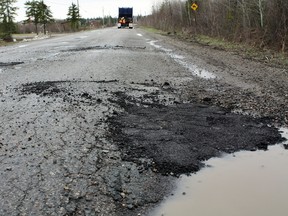
A road in need of repair in Timmins, Ont.
PHOTO BY BENJAMIN AUBÉ/THE TIMMINS DAILY PRESS/QMI AGENCY FILES
There is a certain predictability to springtime in Timmins, a northern Ontario mining town surrounded by lakes, the great boreal forest and the gold deposits that led to its founding more than a century ago and continue to define it today.
It is a town full of stories, although the one Ken Krcel tells, on a late August afternoon, is not about the latest lucky strike, but about a local road maintenance man’s never-ending fight against a much less heralded but no less prominent town feature: potholes.
Big potholes. Small potholes. Potholes that lead to road closures. Potholes that keep Krcel on high alert, particularly in the spring and even more so now amid climate change, because the deep freeze that used to take hold of the north in November and not release its grip until April is now often marked by mid-winter warm spells that heap more pothole-generating stress upon an already aging road network.
“We’ve got more potholes than we can deal with,” the town’s director of public works said. “I don’t drive in the curb lane in the spring. I drive in the fast lane to get away from the potholes.”
At least Krcel knows the town’s cracking, potholed thoroughfares and increasingly unpredictable weather are not outliers. They are just one example of a pan-Canadian crisis gripping municipalities, big and small, that are beset with roads needing repair, and budgets that can’t keep up with the increasing costs. But the solution to this pricey conundrum could come from an unlikely saviour in this dawning age of climate awareness: Alberta crude. That’s not a typo.
The holey road journey from here to the oilsands begins with the drive to get to net-zero emissions by 2050 and wean people off combustion-engine vehicles.

There is a certain predictability to springtime in Timmins, a northern Ontario mining town surrounded by lakes, the great boreal forest and the gold deposits that led to its founding more than a century ago and continue to define it today.
It is a town full of stories, although the one Ken Krcel tells, on a late August afternoon, is not about the latest lucky strike, but about a local road maintenance man’s never-ending fight against a much less heralded but no less prominent town feature: potholes.
Big potholes. Small potholes. Potholes that lead to road closures. Potholes that keep Krcel on high alert, particularly in the spring and even more so now amid climate change, because the deep freeze that used to take hold of the north in November and not release its grip until April is now often marked by mid-winter warm spells that heap more pothole-generating stress upon an already aging road network.
“We’ve got more potholes than we can deal with,” the town’s director of public works said. “I don’t drive in the curb lane in the spring. I drive in the fast lane to get away from the potholes.”
At least Krcel knows the town’s cracking, potholed thoroughfares and increasingly unpredictable weather are not outliers. They are just one example of a pan-Canadian crisis gripping municipalities, big and small, that are beset with roads needing repair, and budgets that can’t keep up with the increasing costs. But the solution to this pricey conundrum could come from an unlikely saviour in this dawning age of climate awareness: Alberta crude. That’s not a typo.
The holey road journey from here to the oilsands begins with the drive to get to net-zero emissions by 2050 and wean people off combustion-engine vehicles.

Going electric won’t be the end of roads.
PHOTO BY MARK BLINCH/REUTERS FILES
Going electric won’t be the end of roads. Canadians are still going to need to get around, and companies are still going to need to haul goods around, but almost 40 per cent of the roads they are currently driving on rate as being in “fair or worse” condition, according to a 2019 Canadian Infrastructure Report Card. About 50 per cent of municipal roads and 30 per cent of highways were built prior to 1970, which means they need replacing.
Spotting the problem is as easy for Joe Canuck as walking out the front door and surveying the scarred, pitted and patchworked asphalt streets beyond. Fixing them will require some creative thinking.
“We need to look at the roads to last, because there is no magic pot of money that is going to give us hundreds of millions of dollars for road rehabilitation,” said Steve Goodman, an Ottawa-based pavement expert with Gemtec Consulting Engineers and Scientists Ltd. “The funding deficit is not a couple million dollars — or even a couple hundred million dollars — it is in the billions.”
Goodman has a doctorate in civil engineering, and a Twitter handle — @PavementDude — that speaks to a consuming passion for assessing road surfaces good and bad. It is a habit without an off-switch, one he carries with him wherever he goes, including the finest cities of Europe, where he will find himself staring at the asphalt instead of some architectural wonder nearby.
Going electric won’t be the end of roads. Canadians are still going to need to get around, and companies are still going to need to haul goods around, but almost 40 per cent of the roads they are currently driving on rate as being in “fair or worse” condition, according to a 2019 Canadian Infrastructure Report Card. About 50 per cent of municipal roads and 30 per cent of highways were built prior to 1970, which means they need replacing.
Spotting the problem is as easy for Joe Canuck as walking out the front door and surveying the scarred, pitted and patchworked asphalt streets beyond. Fixing them will require some creative thinking.
“We need to look at the roads to last, because there is no magic pot of money that is going to give us hundreds of millions of dollars for road rehabilitation,” said Steve Goodman, an Ottawa-based pavement expert with Gemtec Consulting Engineers and Scientists Ltd. “The funding deficit is not a couple million dollars — or even a couple hundred million dollars — it is in the billions.”
Goodman has a doctorate in civil engineering, and a Twitter handle — @PavementDude — that speaks to a consuming passion for assessing road surfaces good and bad. It is a habit without an off-switch, one he carries with him wherever he goes, including the finest cities of Europe, where he will find himself staring at the asphalt instead of some architectural wonder nearby.
The funding deficit is not a couple million dollars — or even a couple hundred million dollars — it is in the billionsSTEVE GOODMAN
“It never stops,” he said.
Goodman studied under “pavement god” Ralph Haas, now deceased, at the University of Waterloo in Ontario. Haas wrote the so-called book on modern pavement management before there was a book on modern pavement management. It was published in 1994. In the decades since, the challenge of managing the country’s aging infrastructure has grown more complex in the face of a changing climate.
Road designers, engineers and builders rely upon historical weather data to set the optimal performance temperature range for a project’s asphalt pavement, which needs to be able to contract without cracking apart in extreme cold temperatures, and to expand without excessively softening in blistering heat.
Failure at the high end can cause the asphalt binder — the crude-oil-derived glue that holds the road together — to liquefy, causing a gooey, nasty mess that costs money to fix. Melting roads were the hot topic around the United Kingdom in July. Stories of “binder bleed” and buckling roads briefly dominated the international news cycle during a once-in-a-lifetime heatwave that, nowadays, seems to be happening once every few years.

In Ottawa, the asphalt pavement is currently graded to withstand a road surface
temperature of 58 C at the upper end, and minus 34 C at the lower.
PHOTO BY JEAN LEVAC/POSTMEDIA FILES
In Ottawa, the asphalt pavement is currently graded to withstand a road surface temperature of 58 C at the upper end, and minus 34 C at the lower. Goodman anticipates the upper number is going to be increased to 64 C in short order.
More problematic is the increasing frequency of the dreaded freeze-thaw cycle. Goodman moved to Ottawa 24 years ago, when winters were as predictable as springtime potholes in Timmins.
“It would get cold here in November and warm up in April,” he said. “Now you can get 15 degrees in January, the snow melts, filters into the pavement, refreezes overnight and then the water expands and it literally blows up the pavement.”
The country’s shoddy roads cost Canadian drivers $3 billion annually, according to a 2021 study by the Canadian Automobile Association (CAA). Getting mechanics to fix a tire rod that falls victim to a nasty pothole doesn’t earn you any discounts, just another headache. And highways that are seemingly under perpetual repair prevent freight trucks from getting where they need to be on time, further sapping productivity.
The CAA study suggests that spending a dollar today on road preservation could eliminate or delay “spending $6-$10 on costly repairs later on.”
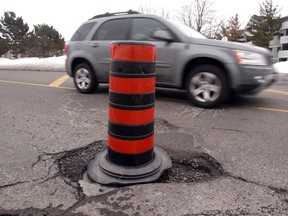
In Ottawa, the asphalt pavement is currently graded to withstand a road surface temperature of 58 C at the upper end, and minus 34 C at the lower. Goodman anticipates the upper number is going to be increased to 64 C in short order.
More problematic is the increasing frequency of the dreaded freeze-thaw cycle. Goodman moved to Ottawa 24 years ago, when winters were as predictable as springtime potholes in Timmins.
“It would get cold here in November and warm up in April,” he said. “Now you can get 15 degrees in January, the snow melts, filters into the pavement, refreezes overnight and then the water expands and it literally blows up the pavement.”
The country’s shoddy roads cost Canadian drivers $3 billion annually, according to a 2021 study by the Canadian Automobile Association (CAA). Getting mechanics to fix a tire rod that falls victim to a nasty pothole doesn’t earn you any discounts, just another headache. And highways that are seemingly under perpetual repair prevent freight trucks from getting where they need to be on time, further sapping productivity.
The CAA study suggests that spending a dollar today on road preservation could eliminate or delay “spending $6-$10 on costly repairs later on.”

The country’s shoddy roads cost Canadian drivers $3 billion annually, study says.
PHOTO BY BRUNO SCHLUMBERGER/THE OTTAWA CITIZEN FILES
But spending money up front, with taxpayers ultimately footing the bill, isn’t necessarily possible, and not simply because road repair isn’t a hot button political issue such as, say, affordable housing, but because a lot of municipalities don’t have the money to do anything more than fill potholes.
“I don’t know if the weather itself is causing us as much grief as the way the North works,” Krcel said. “We just don’t have the population growth here, and so now we are caught with very old infrastructure without the tax base to rebuild it as quickly as it needs to be.”
The gold mines in Timmins are still producing, so heavy ore trucks still rumble through town. But much like other industries, mining requires less people now to do the work. Timmins’ population has been stuck around 40,000 for 40 years.
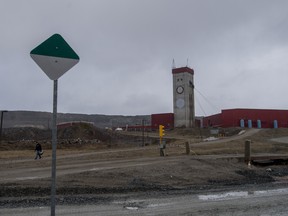
But spending money up front, with taxpayers ultimately footing the bill, isn’t necessarily possible, and not simply because road repair isn’t a hot button political issue such as, say, affordable housing, but because a lot of municipalities don’t have the money to do anything more than fill potholes.
“I don’t know if the weather itself is causing us as much grief as the way the North works,” Krcel said. “We just don’t have the population growth here, and so now we are caught with very old infrastructure without the tax base to rebuild it as quickly as it needs to be.”
The gold mines in Timmins are still producing, so heavy ore trucks still rumble through town. But much like other industries, mining requires less people now to do the work. Timmins’ population has been stuck around 40,000 for 40 years.

The site of Porcupine Gold Mines in Timmins, Ont.
PHOTO BY TYLER ANDERSON/NATIONAL POST FILES
Over roughly the same span, York Region, which encompasses the collection of municipalities bordering Toronto’s northern edge, and where Krcel got his start working on roads right out of college, has grown from a few hundred thousand people to almost 1.2 million.
“Without growth, we can’t rebuild our roads at the same pace,” Krcel said.
As a result, there is a pressing need for civil engineers, city engineers, road design nerds and extremely smart university professors to apply some creative, cost-conscious thinking to the country’s road headaches.
Simon Hesp has some ideas. He is an asphalt-pavement focused chemical engineering professor at Queen’s University in Kingston, Ont., and he said the answer to our infrastructure crisis is found in Alberta. Specifically, in the oilsands.
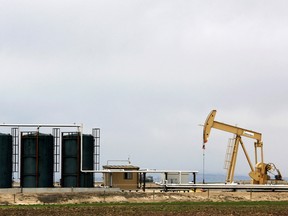
Over roughly the same span, York Region, which encompasses the collection of municipalities bordering Toronto’s northern edge, and where Krcel got his start working on roads right out of college, has grown from a few hundred thousand people to almost 1.2 million.
“Without growth, we can’t rebuild our roads at the same pace,” Krcel said.
As a result, there is a pressing need for civil engineers, city engineers, road design nerds and extremely smart university professors to apply some creative, cost-conscious thinking to the country’s road headaches.
Simon Hesp has some ideas. He is an asphalt-pavement focused chemical engineering professor at Queen’s University in Kingston, Ont., and he said the answer to our infrastructure crisis is found in Alberta. Specifically, in the oilsands.

An oil and gas pump jack in Alberta.
PHOTO BY TODD KOROL/REUTERS FILES
Hesp’s research has shown that Alberta crude produces asphalt binder — that black sticky stuff that holds asphalt together — of virtually unparalleled quality.
“Russian crude? No comparison,” he said. “Crude from the Middle East? No comparison. Crude from China, India? No comparison. Alberta and Venezuelan crude perform better than anything else in the world.”
Asphalt has a limited life cycle. In Ontario, it ranges between 15 and 25 years. Hesp, in collaboration with some municipalities, including Timmins, has test sections of road made with straight Alberta binder that are showing a predicted life cycle of 40 years.
Hesp’s research has shown that Alberta crude produces asphalt binder — that black sticky stuff that holds asphalt together — of virtually unparalleled quality.
“Russian crude? No comparison,” he said. “Crude from the Middle East? No comparison. Crude from China, India? No comparison. Alberta and Venezuelan crude perform better than anything else in the world.”
Asphalt has a limited life cycle. In Ontario, it ranges between 15 and 25 years. Hesp, in collaboration with some municipalities, including Timmins, has test sections of road made with straight Alberta binder that are showing a predicted life cycle of 40 years.
“If we do it smarter, I am sure we can make it 60 years,” he said.
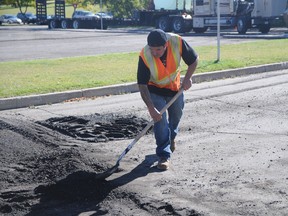
Research shows that Alberta crude produces asphalt binder of virtually unparalleled quality.
PHOTO BY KIRSTEN GORUK/DAILY HERALD-TRIBUNE/QMI AGENCY AGENCY FILES
The professor sketches a bright, future-facing picture, full of electric vehicles rolling over freshly paved, built-to-last roads held together with Alberta bitumen, and an oil industry that hasn’t been left for dead by electrification, but pivoted to a new calling: building roads.
“Alberta has enough reserves underground to pave every road on Earth for the next 100 to 200 years,” Hesp said.
But even good ideas have entrenched interests to navigate. As it stands, the asphalt-binder wholesale industry is somewhat of a hodgepodge: quality control can often be hit and miss, and the gooey stuff from oil refineries, even if it’s of the good variety, can be cut with additives, including recycled motor oil and shingles, that don’t fare well when cars are travelling over them.
Alberta has enough reserves underground to pave every road on Earth for the next 100 to 200 yearsSIMON HESP
Then there’s politics. A 2016 Ontario Auditor General’s report revealed that the province’s Ministry of Transportation (MTO) identified issues of premature pavement cracking as early as 2000, but had done next to nothing to address it. Worse, any policy changes enacted were driven by private contractors for their benefit “over the taxpayers’ best interests,” the report said.
The MTO has since strengthened its pavement-testing protocols and tightened its standards around the use of motor oil additives and such, but the road work that was done all those years when nothing was being done at the political level continues to fall apart prematurely.
Back in Timmins, Ken Krcel was getting ready to head out to the cottage for the Labour Day long weekend. The town has embraced Hesp’s enthusiasm for Alberta binder and is seeing the results. Roads that were repaired, pre-Hesp experimentation, are full of cracks; roads that have been fixed with the Alberta goo aren’t showing any wear six years after being laid.
By the road man’s best count, his pothole repair crews have filled about 15,000 potholes since the spring melt. Now, fall is in the air, and the cycle is set to begin anew.
“Someday, we will get caught up on the work,” Krcel said.
Someday.
• Email: joconnor@nationalpost.com | Twitter: oconnorwrites
No comments:
Post a Comment